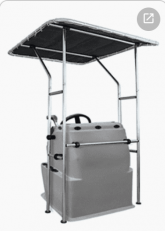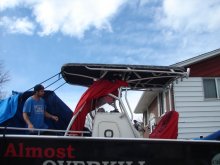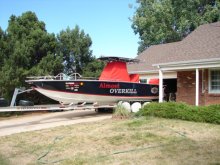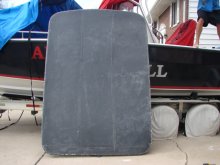This is for REN3, but I'm writing in response to K8MEJ.
The newest "shingled" semi-flexible panels appear to be MUCH less prone to dying at a young age. I've been installing them exclusively (on a couple of TTs, and also a class-B) ever since they became widely available - even though my own Travel Trailer has "old style" thin-film cells exclusively. In the newer "shingled" panels, the top-cover film is a much thicker and stronger layer of plastic, covering both the angled "faces" and the edges of the cells underneath.
My Class-B customer took her RV to Snowmass in late February, and literally pulled off two heavy snowfalls (from the panel faces) by using an automotive "snow brush". Absolutely no damage resulted from heavy brushing. I would never dare to that on my that own thin-film cells, because the top layer is so much more prone to cracking. I will be surprised if these "shingled" panels can't survive 6-10 years, exposed to weather at the dock every day, if installed with VHB tape on a relatively firm carbon-fiber surface.
- - - -
With all that said, the T-Top will have some flex in wind and changing angles of travel. I would actually ignore the "cooling requirement", and instead attach the panels with VHB tape around the perimeter edges. My own TT, and most of the TT's for which I make design and installation recommendations (as well as the 3 I've done personally), are all built with very flexible aluminium fold out "shells". This mounting scheme has NEVER failed:
Clean the mounting surface. On each panel (the panels which I recommend are about 23" wide), put 3 6" segments of 1" wide VHB tape along a short edge. The outside segments reach all the way to the corner, the middle segment is separated from the outside pieces by gaps of about 2". This is INTENTIONAL - water spray from high speed travel (towing at RV on the freeway in the wind, or a boat) is allowed to get under the panel through these tiny gaps. But the gaps also DRAIN the panel, both for water and water vapor when heated, preventing any damage to the plastic sheet on the bottom.
Along the adjacent sides, continue with VHB tape (segments of 5-6", separated by gaps of about 1-1/2 inch). When mounting, you don't need to put all the tape down at once. From your picture of the T-top removed and standing nearly vertical on the driveway, I recommend starting from the bottom and working your way upwards. Or you can lay it flat. When you press in one edge, the middle of the panel can be held off from the T-top surface by a segment of 2x4. As you work your way towards the other end, adding VHB segments along the side, you move the 2x4 closer to the free end before pressing in those VHB segments.
Along the length, I traditionally add one or two very small segments in the middle of the panel (perhaps 3" long) to reduce any tendency for the panel to "flap up and down" in the middle. My VHB tape choice has always been RP-32, in one-inch rolls. Although they might work, I have never used any "thicker" version, because more foam creates less strength. I would also not go any thinner than RP-25, because thinner tapes don't allow for enough flex between the T-top and the "semi-flexible" panels.
- - -
The panels I now recommend (exclusively, for "semi-flexible" applications) are these:
https://www.ebay.com/itm/2-100W-Fle...or-Camping-RV-Caravan-Van-Marine/283716192472. The Ebay seller has a great "reputation", and I've bought from him/them many times.
One Amazon version of the tape which matches my requirement is this one:
https://www.amazon.com/gp/product/B007Y7DVH6/ref=ppx_yo_dt_b_asin_title_o05_s00?ie=UTF8&th=1. It's an "RP-25" tape, and you would need a bit less than 2 of the 18-yard rolls, in order to mount 6 panels.






